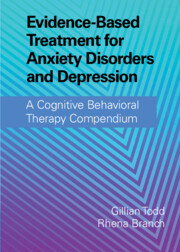 Evidence-Based Treatment for Anxiety Disorders and Depression
Evidence-Based Treatment for Anxiety Disorders and Depression Book contents
- Evidence-Based Treatment for Anxiety Disorders and Depression
- Evidence-Based Treatment for Anxiety Disorders and Depression
- Copyright page
- Contents
- Figures
- Tables
- Contributors
- 1 Introduction
- 2 The History and Philosophical Underpinnings of CBT:
- Part One Cognitive Behavioral Therapy for Anxiety Disorders
- Part Two Cognitive Behavioral Therapy for Posttraumatic Stress Disorder
- Part Three Cognitive Behavioral Therapy for Obsessive-Compulsive Disorder and Associated Disorders
- Part Four Cognitive Behavioral Therapy for Depression
- 18 Behavioral Activation
- 19 CBT for Persistent Depressive Disorder
- 20 Rumination-Focused Cognitive Behavioral Therapy
- 21 Cognitive Behavioral Therapy for Perinatal Depression
- Part Five Complexity and Comorbidity in Anxiety Disorders and Depression:
- Part Six Specialist Applications of Cognitive Behavioral Therapy for Anxiety Disorders and Depression
- Part Seven Future Developments
- Appendices
- Index
- References
18 - Behavioral Activation
from Part Four - Cognitive Behavioral Therapy for Depression
Published online by Cambridge University Press: 06 January 2022
- Evidence-Based Treatment for Anxiety Disorders and Depression
- Evidence-Based Treatment for Anxiety Disorders and Depression
- Copyright page
- Contents
- Figures
- Tables
- Contributors
- 1 Introduction
- 2 The History and Philosophical Underpinnings of CBT:
- Part One Cognitive Behavioral Therapy for Anxiety Disorders
- Part Two Cognitive Behavioral Therapy for Posttraumatic Stress Disorder
- Part Three Cognitive Behavioral Therapy for Obsessive-Compulsive Disorder and Associated Disorders
- Part Four Cognitive Behavioral Therapy for Depression
- 18 Behavioral Activation
- 19 CBT for Persistent Depressive Disorder
- 20 Rumination-Focused Cognitive Behavioral Therapy
- 21 Cognitive Behavioral Therapy for Perinatal Depression
- Part Five Complexity and Comorbidity in Anxiety Disorders and Depression:
- Part Six Specialist Applications of Cognitive Behavioral Therapy for Anxiety Disorders and Depression
- Part Seven Future Developments
- Appendices
- Index
- References
Summary
Behavioral activation (BA) is a brief intervention based on the reinforcement theory of depression that aims to increase an individual’s engagement in rewarding activities as a means to increase response-contingent positive reinforcement. BA has emerged as an empirically supported treatment for depression that is particularly amenable for implementation in diverse clinical contexts. The need for short-term, evidence-based treatments in the era of managed care has contributed to the increasing use of BA worldwide. This chapter provides a historical overview of BA and provides a targeted review of the principles and procedures of a brief, contemporary behavioral activation approach, including recommendations for using this approach in the assessment and treatment of depression, and with individuals with multiple levels of physical and mental health comorbidities.
Keywords
- Type
- Chapter
- Information
- Evidence-Based Treatment for Anxiety Disorders and DepressionA Cognitive Behavioral Therapy Compendium, pp. 367 - 382Publisher: Cambridge University PressPrint publication year: 2022
